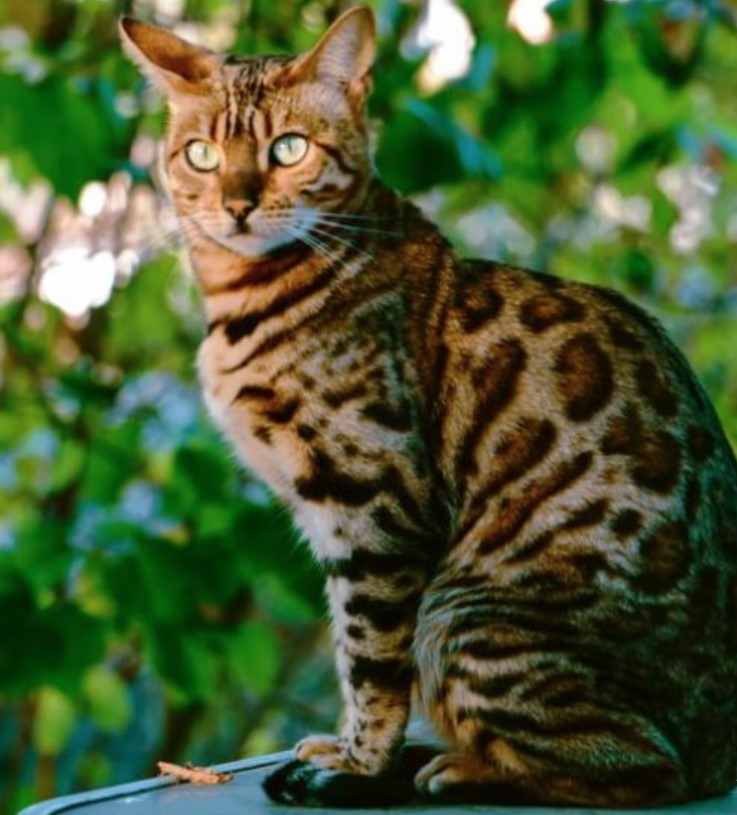With the Bengal cat, man fulfilled a long-awaited wish. He created a cat as beautiful as a wild cat and as gentle as a domestic cat, a little tiger for your own living room.

Size: Medium – large;
Weight: Female / male 4 kg / 5.5 kg;
Life expectancy: Approx. 15 years;
Physique: The cat is muscular, elongated, and robust;
Coat Colors: The Bengal has clear, high-contrast markings of seal or brown on a golden-orange base color;
Special features regarding the appearance: Unique shimmering effect of the fur, as if covered with “laburnum”;
Breed type: hybrid breed;
Country of origin: United States;
Recognized cat breed by WCF, FIFE, TICA;
Typical breed diseases: Not known.
Bengal pedigree cats – Small leopards for the home

Nature
A Bengal cat is not for beginners! She is an extremely perceptive and inquisitive cat who likes to be kept busy and challenged. If she’s bored, she’ll do anything to get your attention. Drawers and cupboards are interesting toys for the Bengal where treats could be hiding. Even the fish in the aquarium are not safe from her. Don’t blame her – it’s the wild cat that’s in her!
Although the Bengal is a very independent pedigree cat, it demands a lot of attention from its owner. If you want to call a Bengal cat your own, you should have plenty of time and motivation. It is important not to underestimate the still clearly recognizable behavioral pattern of the originally crossed wildcat. A Bengal feels at home in nature. Give her the opportunity to develop freely! A large outdoor enclosure with trees or beams for climbing is ideal for species-appropriate housing.
Appearance

The typical spotted coat pattern of the Bengal cat gives an idea of its wild roots. Its origin is based on crossing a short-haired house cat with an Asian leopard cat, whereby the external characteristics of the wild cat were combined with the characteristics of the house cat. The Bengal cat’s supple physique and unusual coat pattern make it appear truly majestic.
Allowed colors include Brown (black), Snow (Lynx Point, Sepia, Mink), and Silver (Spotted-tabby, Marble). Occasionally it seems as if the cats were covered with laburnum. This silky shimmer effect is unique among pedigree cats and is highly appreciated by enthusiasts, but is not essential for successful breeding.
History and origin

Humans have always been fascinated by the majestic beauty and sovereign temperament of all wild cats. There have been many failed attempts to habituate wild cats such as ocelots, cheetahs, and even lions to humans. In order to finally fulfill the wish for the “leopard in the living room”, people began to cross domestic cats with wild cats. In 1963, Jean S. Muhle laid the foundation for the Bengal breeding program.
Health

Feline Infectious Peritonitis (FIP), an infectious disease, can occasionally occur among the breed. Cats that carry the disease develop peritonitis, which usually leads to death. Of all pedigree cats, Bengals, Siamese, Maine Coons, and Abyssinians are particularly susceptible to Tritrichomonas fetus, a parasite that can cause chronic diarrhea.
A species-appropriate and balanced diet for the cat is important for a strong immune system and a long and happy cat life. Obesity is considered to be the biggest and most dangerous consequence of poor nutrition. Also important is the annual check-up at the vet and the associated vaccinations against cat cold and cat disease. Outdoor cats should also be vaccinated against rabies and feline leukemia.





























